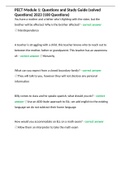Strategic Management – lecture notes
Lecture 1: Strategy, goals and performance
There is not 1 definition for ‘strategy’. It depends on the paradigm you come from.
- A unified, comprehensive, and integrated plan… designed to ensure that the basis
objectives of the enterprise are achieved
- A timed sequence of internally consistent and conditional resource allocation
decisions designed to fulfil an organization’s objectives
- A conceptualization of long-term objectives, broad constraints and near-term plans
set by the executive and currently in operation
- The decision process that conjoins the firm’s capability with the opportunities and
threats in its environment
- A broad formula for how a firm will compete, what its goals should be, and what
policies are needed to carry out those goals
- The creation of a sustainable competitive advantage
Your strategy depends on what your competitors are doing.
When is an advantage sustainable?
- When your rivals give up beating you
- Apple quiet industry secrets before a launch
- No good definitions of how log sustainable is
- Depends on industry
There is just 1 industry leader: One strategy, the rest anticipates.
Mintzberg’s Five P’s for strategy
1. Plan
a) Business plan, you need one in your mind.
b) Consciously intended course of action. Plan made before actions.
c) Short term strategies better! Market is more turbulent, so writing long business
plans is outdated.
2. Ploy (schijnbeweging)
a) Small manoeuvre, tactic
b) Football
c) Is useful in a specific situation, but will not help you win the game.
1
, 3. Pattern
a) Stream of actions
b) Observe and try to find out the strategy
c) Intended strategy: your plan
d) Unrealized strategy: what is not realized
e) Deliberate strategy: what gets implemented
f) Emergent strategy: accidently notice. ‘Maybe make this part of our strategy’
4. Position (positional approach to strategy)
a) Niche in the environment
b) Resources
c) Porter’s 5 forces
1. Rivals: Be there alone is nice
2. Buyers: Just 1? You don’t have much bargaining power
3. Supplier: just 1? You are vulnerable
4. Substitutes
5. Potential entrants
5. Perspective
a) Firms compete on organizational culture
b) Shared norms, values
c) IKEA is not shipping air
2
,My view of strategy
Goal-driven
Implies a set of actions you have to do something in order to accomplish your goals
Intentional
Not necessarily formal planning. Plan in your head is also fine.
Not unconscious patterns of actions if you are not aware of what you did, than it
cannot be considered as a strategy.
But emergent strategies are included
o Originate from unconscious/unintended actions in the past
o Awareness of pattern modify current/future intentions
- Respond quickly to change
- If you are good in spotting trends, you get a strong position.
- Aided by own resources:
o Spending a lot of money in fabrics can lead to inflexibility, because it’s hard to
undo the investment.
o With too much money you put pressure on smaller players with stealing and
copying ideas.
Environment: you need to know what your customer wants.
Resources: hurt or help you. ‘We make big cars’ But, the environment… ‘We make big cars.’
Influence between actor and environment
- Social enactment process: how did they accomplish their current position?
- I am the actor, the rivals are the environment
Value system: all the environment and all the structures
3
, Mission: why does the organization exists? What business are we in? Overall purpose of the
organization.
Functions of a mission statement
- Direction: defining the boundaries of strategic choices and actions
- Legitimization: convince stakeholders that the firm is pursuing valuable actives in a
proper way. Goal is to create the image that your organization should exists which can
result in investors.
- Motivation: inspiring individuals to work together in a particular way
Vision:
- The desired future state of the organization
- The aspirations on which strategists are trying to focus attention
- Relatively vague, many details left out, like political promises.
Goals:
- General aim in line with the mission.
- More short-term.
Objectives:
- Usually quantitative or at least more precise targets.
- Relatively concrete milestones/benchmarks in line with the goals.
- Very short term
Classical framework of strategic management
- Y model
- Mission should be in line with external and internal environment
4
Lecture 1: Strategy, goals and performance
There is not 1 definition for ‘strategy’. It depends on the paradigm you come from.
- A unified, comprehensive, and integrated plan… designed to ensure that the basis
objectives of the enterprise are achieved
- A timed sequence of internally consistent and conditional resource allocation
decisions designed to fulfil an organization’s objectives
- A conceptualization of long-term objectives, broad constraints and near-term plans
set by the executive and currently in operation
- The decision process that conjoins the firm’s capability with the opportunities and
threats in its environment
- A broad formula for how a firm will compete, what its goals should be, and what
policies are needed to carry out those goals
- The creation of a sustainable competitive advantage
Your strategy depends on what your competitors are doing.
When is an advantage sustainable?
- When your rivals give up beating you
- Apple quiet industry secrets before a launch
- No good definitions of how log sustainable is
- Depends on industry
There is just 1 industry leader: One strategy, the rest anticipates.
Mintzberg’s Five P’s for strategy
1. Plan
a) Business plan, you need one in your mind.
b) Consciously intended course of action. Plan made before actions.
c) Short term strategies better! Market is more turbulent, so writing long business
plans is outdated.
2. Ploy (schijnbeweging)
a) Small manoeuvre, tactic
b) Football
c) Is useful in a specific situation, but will not help you win the game.
1
, 3. Pattern
a) Stream of actions
b) Observe and try to find out the strategy
c) Intended strategy: your plan
d) Unrealized strategy: what is not realized
e) Deliberate strategy: what gets implemented
f) Emergent strategy: accidently notice. ‘Maybe make this part of our strategy’
4. Position (positional approach to strategy)
a) Niche in the environment
b) Resources
c) Porter’s 5 forces
1. Rivals: Be there alone is nice
2. Buyers: Just 1? You don’t have much bargaining power
3. Supplier: just 1? You are vulnerable
4. Substitutes
5. Potential entrants
5. Perspective
a) Firms compete on organizational culture
b) Shared norms, values
c) IKEA is not shipping air
2
,My view of strategy
Goal-driven
Implies a set of actions you have to do something in order to accomplish your goals
Intentional
Not necessarily formal planning. Plan in your head is also fine.
Not unconscious patterns of actions if you are not aware of what you did, than it
cannot be considered as a strategy.
But emergent strategies are included
o Originate from unconscious/unintended actions in the past
o Awareness of pattern modify current/future intentions
- Respond quickly to change
- If you are good in spotting trends, you get a strong position.
- Aided by own resources:
o Spending a lot of money in fabrics can lead to inflexibility, because it’s hard to
undo the investment.
o With too much money you put pressure on smaller players with stealing and
copying ideas.
Environment: you need to know what your customer wants.
Resources: hurt or help you. ‘We make big cars’ But, the environment… ‘We make big cars.’
Influence between actor and environment
- Social enactment process: how did they accomplish their current position?
- I am the actor, the rivals are the environment
Value system: all the environment and all the structures
3
, Mission: why does the organization exists? What business are we in? Overall purpose of the
organization.
Functions of a mission statement
- Direction: defining the boundaries of strategic choices and actions
- Legitimization: convince stakeholders that the firm is pursuing valuable actives in a
proper way. Goal is to create the image that your organization should exists which can
result in investors.
- Motivation: inspiring individuals to work together in a particular way
Vision:
- The desired future state of the organization
- The aspirations on which strategists are trying to focus attention
- Relatively vague, many details left out, like political promises.
Goals:
- General aim in line with the mission.
- More short-term.
Objectives:
- Usually quantitative or at least more precise targets.
- Relatively concrete milestones/benchmarks in line with the goals.
- Very short term
Classical framework of strategic management
- Y model
- Mission should be in line with external and internal environment
4










